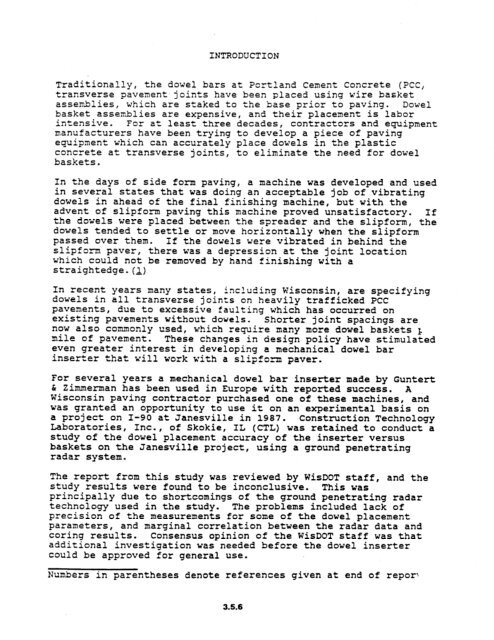chapter 3 rigid pavement - DOT On-Line Publications - Department ...
chapter 3 rigid pavement - DOT On-Line Publications - Department ...
chapter 3 rigid pavement - DOT On-Line Publications - Department ...
You also want an ePaper? Increase the reach of your titles
YUMPU automatically turns print PDFs into web optimized ePapers that Google loves.
INTRODUCTION<br />
Traditionally, the dowel bars at Portland Cement Concrete (PCC,<br />
transverse <strong>pavement</strong> joints have been placed using wire basket<br />
assemblies, which are staked to the base prior to paving. Dowel<br />
basket assemblies are expensive, and their placement is labor<br />
intensive. For at least three decades, contractors and equipment<br />
manufacturers have been trying to develop a piece of paving<br />
equipment which can accurately place dowels in the plastic<br />
concrete at transverse joints, to eliminate the need for dowel<br />
baskets.<br />
In the days of side form paving, a machine was developed and used<br />
in several states that was doing an acceptable job of vibrating<br />
dowels in ahead of the final finishing machine, but with the<br />
advent of slipform paving this machine proved unsatisfactory. If<br />
the dowels were placed between the spreader and the slipform, the<br />
dowels tended to settle or move horizontally when the slipform<br />
passed over them. If the dowels were vibrated in behind the<br />
slipform paver, there was a depression at the joint location<br />
which could not be removed by hand finishing with a<br />
straightedge.(l)<br />
In recent years many states, including Wisconsin, are specifying<br />
dowels in all transverse joints on heavily trafficked PCC<br />
<strong>pavement</strong>s, due to excessive faulting which has occurred on<br />
existing <strong>pavement</strong>s without dowels. Shorter joint spacings are<br />
now also commonly used, which require many more dowel baskets &<br />
mile of <strong>pavement</strong>.<br />
These changes in design policy have stimulated<br />
even greater interest in developing a mechanical dowel bar<br />
inserter that will work with a slipform paver.<br />
For several years a mechanical dowel bar inserter made by Guntert<br />
C Zimmerman has been used in Europe with reported success. A<br />
Wisconsin paving contractor purchased one of these machines, and<br />
was granted an opportunity to use it on an experimental basis on<br />
a project on I-90 at Janesville in 1987. Construction Technology<br />
Laboratories, Inc., of Skokie,<br />
IL (CTL) was retained to conduct a<br />
study of the dowel placement accuracy of the inserter versus<br />
baskets on the Janesville project, using a ground penetrating<br />
radar system.<br />
The report from this study was reviewed by Wis<strong>DOT</strong> staff, and the<br />
study results were found to be inconclusive. This was<br />
principally due to sh&tcomings of the ground penetrating radar<br />
technology used in the study. The problems included lack of<br />
precision of the measurements for some of the dowel placement<br />
parameters, and marginal correlation between the radar data and<br />
coring results. Consensus opinion of the Wis<strong>DOT</strong> staff was that<br />
additional investigation was needed before the dowel inserter<br />
could be approved for general use.<br />
Numbers in parentheses denote references given at end of repor<br />
3.5.6
















